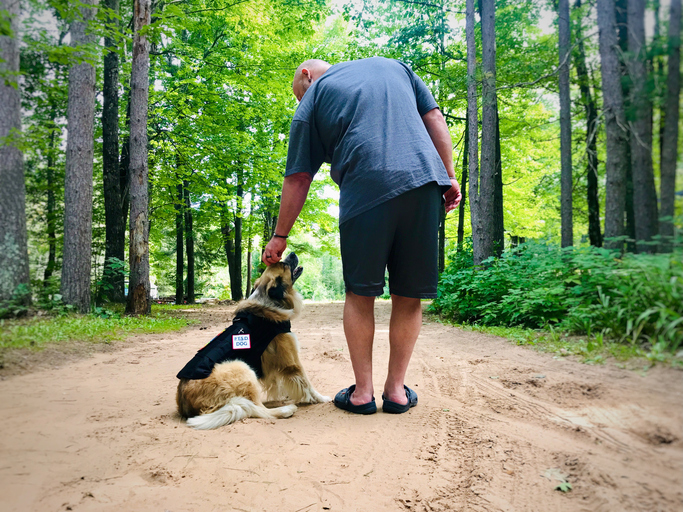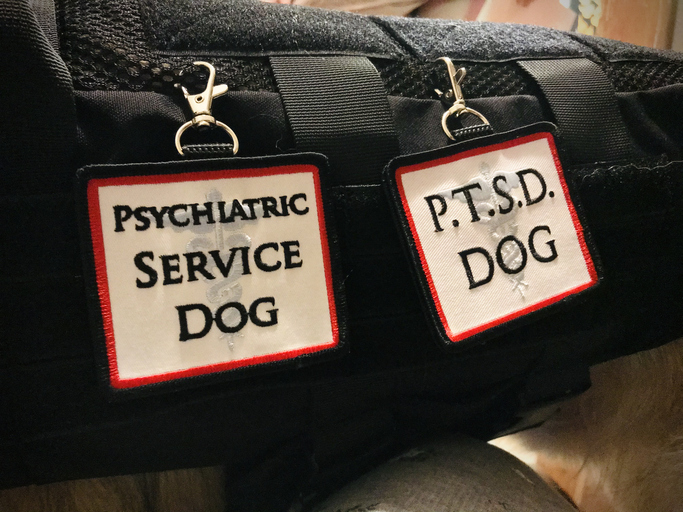Service Dogs Can Be Invaluable in Helping People with PTSD
Posttraumatic stress disorder (PTSD) affects an estimated one in seven adults at some time in their lives and it affects a large proportion of military members and veterans. In addition to the variety of effective treatments available, people often also use complementary interventions, such as the use of trained PTSD service dogs. These service dogs perform specific tasks that help address PTSD symptoms, such as applying pressure to alleviate anxiety and nudging to interrupt flashbacks.
Previous research has found benefits of the PTSD service dogs such as reduced severity of symptoms, improved mental health and improved social interactions. Now, new research takes an in-depth look at what makes the partnerships work and what characteristics lead to the most effective results. As with people and their companion dogs, the researchers note, each veteran-service dog partnership “is unique and multi-dimensional.”

The study involved 82 military members and veterans assigned to partner with a PTSD service dog. The participants were assessed prior to getting their service dog and then again after having the dog for three months. They were asked about how often their service dog carried out specific PTSD-related tasks. Below are some examples of tasks service dogs might be trained to perform, along with a description of how they might carry out the task.
- Interrupt/alert to anxiety - nudging or placing its head in the veteran’s lap.
- Calm/comfort from anxiety - laying on top of or leaning against the veteran.
- Block (create space) - positioning their bodies in front of the veteran.
- Cover (watch back) - positioning their bodies behind the veteran and letting them know if someone is approaching.
- Make a friend - initiating a friendly approach or offering someone their paw.
- Wake from a nightmare – recognizing the veteran is having a nightmare and gently waking them up.

In addition to feedback from the service members/veterans, the study dogs wore collars which allowed monitoring for activity (beyond just moving around the house) and proximity to the handler. The study found that on average, the veterans spent more than 80% of their day with their service dog, and the majority of veterans (52%) spent less than 17% of the day apart. The task most frequently performed by the service dogs was to calm/comfort anxiety, reported in 52% of daily check-ins. The next most frequently reported tasks — interrupt/alert to anxiety and make a friend — were reported in 18% of daily check-ins each.
The study looked at a range of the dogs’ characteristics and temperaments and found most were not associated with the outcomes. However, they did find that veterans partnered with service dogs who were less excitable when approached by a stranger had less PTSD severity compared with those with dogs who were more excitable. It’s important to note that “even though all the dogs had been screened and selected for low excitability and trained to reduce excitability, there were still enough differences to impact the outcomes,” according to the study authors. They also point out that the dogs who were slightly more excitable might be better suited for serving other individuals, such as someone who is Deaf or hard of hearing, rather than someone with PTSD.
In addition to the specific PTSD-related functions, the dogs can benefit their handlers in a range of other ways, such as a generally calming physical presence, bringing non-judgmental companionship and joy into the person’s life, bringing routine and responsibility, and helping the veteran connect with family and with others in social situations.
References
- Jensen, CL, Rodriguez, KE, MacLean, EL, et al.Characterizing veteran and PTSD service dog teams: Exploring potential mechanisms of symptom change and canine predictors of efficacy. PLOS ONE, 2022; 17 (7): e0269186.<
- National Institute of Mental Health. Mental Health Statistics: Posttraumatic Stress Disorder. NIMH » Post-Traumatic Stress Disorder (PTSD) (nih.gov)
- Rodriguez, KE., LaFollette MR., Hediger K., et al. (2020). Defining the PTSD Service Dog Intervention: Perceived Importance, Usage, and Symptom Specificity of Psychiatric Service Dogs for Military Veterans. Frontiers in Psychology, Vol.11.
